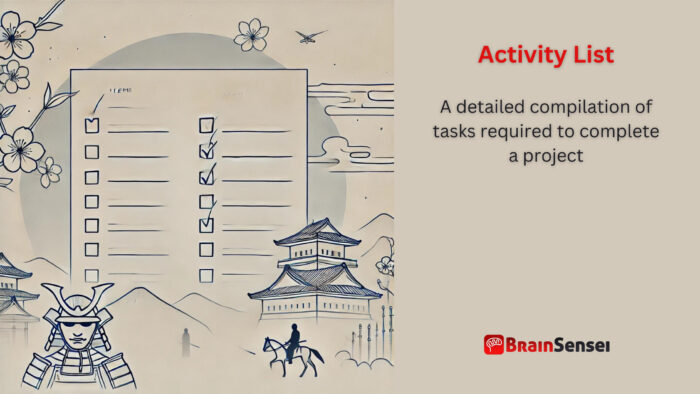
Activity List
What is an Activity List?
In project management, an activity list is a detailed compilation of tasks required to complete a project. Each activity is clearly defined with its scope, sequence, and dependencies, ensuring that teams understand what needs to be done, when, and how.
Key Takeaways
- Provides a clear breakdown of project tasks
- Helps in tracking task dependencies and sequences
- Serves as a foundation for project scheduling and resource allocation
- Enhances communication and understanding across project teams
- It is essential for monitoring project progress and identifying potential delays
Understanding the Activity List
How It Works
The project team typically develops an activity list during the project planning phase. It identifies all work packages from the Work Breakdown Structure (WBS) and breaks them into smaller, manageable tasks. The team documents each activity with details such as descriptions, dependencies, resources, and duration estimates.
Key Steps in Creating an Activity List
- Identify Activities: Break down work packages into discrete tasks.
- Define Activity Attributes: Document dependencies, resource requirements, and constraints.
- Sequence Activities: Arrange tasks based on their dependencies.
- Validate with Stakeholders: Ensure accuracy and completeness.
Important Considerations
- Misidentification of tasks can cause project delays.
- Correctly establish activity dependencies to avoid scheduling conflicts.
- Regular updates are essential and a cornerstone of the activity list. They ensure that changes and progress are accurately reflected, keeping everyone informed and in control of the project’s direction.
- It’s important to remember that incomplete lists can lead to resource misallocation, a risk project managers should always be cautious of and attentive to.
Related Terms
- Work Breakdown Structure (WBS): A hierarchical project breakdown into work packages.
- Project Schedule: A timeline that organizes and schedules project activities.
- Dependency: The relationship between activities, such as finish-to-start or start-to-start.
- Milestone: A significant event in the project timeline.
- Critical Path: The most extended sequence of dependent activities determines project duration.
Examples of Activity Lists Across Industries
Construction Industry
An activity list in a commercial building project might include site preparation, foundation laying, structural framing, electrical wiring, plumbing installation, and final inspections. Each task is linked to subsequent tasks, ensuring efficient sequencing and minimizing idle time. For instance, site preparation involves soil testing, clearing debris, and obtaining necessary permits. Foundation laying requires setting rebar, pouring concrete, and curing it adequately. Structural framing tasks encompass steel erection, frame alignment, and welding. Electrical wiring includes conduit installation, cable pulling, and circuit testing. Plumbing work entails pipe fitting, pressure testing, and fixture installation. Finally, the inspection phase covers quality checks, safety evaluations, and system certifications.
Healthcare Industry
When implementing a new hospital information system, the activity list may cover tasks such as software selection, data migration, system configuration, staff training, and pilot testing. Document dependencies like training following system configuration. The software selection phase includes requirements gathering, vendor assessment, and procurement. Data migration involves extracting, transforming, and loading existing records. System configuration tasks cover interface customization, module integration, and performance optimization. Staff training entails curriculum development, session scheduling, and feedback collection. Pilot testing includes test case design, execution, and results analysis. Continuous monitoring ensures system reliability post-implementation.
Telecommunications Industry
Activities for a new cellular tower installation include site survey, permit acquisition, equipment procurement, tower construction, and signal testing. Proper sequencing ensures that construction starts only after obtaining the necessary permits. The site survey process involves location scouting, topographical analysis, and signal strength measurement. Permit acquisition tasks cover application submission, regulatory coordination, and approval receipt. Equipment procurement entails supplier selection, contract negotiation, and delivery logistics. Tower construction includes foundation pouring, tower assembly, and antenna installation. Signal testing involves equipment calibration, performance assessment, and optimization. Meticulous planning of each phase avoids delays and cost overruns.
Manufacturing Industry
The activity list might detail equipment installation, production line setup, quality control measures, and workforce training in a car manufacturing project. Equipment installation requires procurement, transportation, and setup of machinery. Production line setup involves workstation arrangement, conveyor belt calibration, and process synchronization. Quality control measures include standards development, testing protocols, and defect analysis. Workforce training covers curriculum preparation, skills workshops, and performance evaluation. Document regular maintenance schedules to ensure equipment longevity and operational efficiency.
Retail Industry
For the launch of a new retail store, tasks include site selection, lease negotiation, store design, inventory procurement, and staff hiring. Site selection requires demographic analysis, competitor assessment, and accessibility review. Lease negotiation involves contract drafting, legal review, and agreement finalization. Store design tasks cover layout planning, interior decoration, and equipment installation. Inventory procurement entails supplier selection, purchase order management, and stock delivery. Staff hiring includes job posting, candidate interviews, and onboarding. Outline marketing activities such as promotional campaigns and grand opening events.
These examples illustrate the versatility of activity lists across diverse industries. By meticulously planning tasks, organizations can improve efficiency, reduce risks, and achieve project goals within the stipulated timelines.
Use Cases of Activity Lists Worldwide
United States (Software Development)
A software development company in the United States uses an activity list to manage a new application release. Tasks include requirements gathering, coding, testing, and deployment. The list helps the team track progress, allocate resources, and meet deadlines. The development process begins with detailed requirements gathering, where the team interviews stakeholders and conducts market research to define functionality and performance needs. Next, the coding phase involves assigning tasks to developers, setting milestones, and writing clean, efficient code. Testing follows, with the team running unit, integration, and user acceptance tests to identify and resolve bugs. Finally, the deployment phase includes preparing the production environment, launching the application, and monitoring its performance post-launch.
Germany (Automotive Manufacturer)
A German automotive manufacturer applies an activity list for a new production line installation. The project team aligned the equipment procurement, site preparation, and staff training with delivery schedules. The project starts with supplier selection and contract negotiations to procure high-quality machinery. Site preparation involves facility layout adjustments, electrical infrastructure upgrades, and safety inspections. Staff training covers technical skills for machine operation and safety protocols to prevent workplace accidents. The activity list includes test runs and quality assurance checks to ensure the new production line meets operational standards and targets.
Japan (Construction Firm)
A Japanese construction firm utilizes an activity list to oversee a skyscraper project in Tokyo. The list includes tasks like land excavation, materials procurement, and structural assembly, with strict adherence to safety and regulatory requirements. Land excavation requires soil testing, excavation planning, and debris removal. Materials procurement entails supplier selection, order placement, and delivery scheduling. Structural assembly involves erecting steel frameworks, installing concrete panels, and integrating mechanical systems. Reinforce safety protocols through regular site inspections and worker training sessions. Additionally, the project plan incorporates contingency activities to address potential risks such as adverse weather conditions or supply chain disruptions.
South Africa (Energy Company)
An energy company in South Africa uses an activity list to implement a new solar power plant. Tasks include site selection, panel installation, system integration, and performance testing. Site selection requires solar potential analysis, environmental impact assessments, and community consultations. Panel installation involves foundation setup, panel mounting, and electrical wiring. System integration includes connecting the panels to inverters, setting up control systems, and linking the plant to the national grid. Performance testing assesses energy output, system stability, and safety compliance. The project concludes with staff training and public outreach initiatives to promote the new facility.
Dubai (Logistics Company)
A logistics company in the UAE develops an activity list for a new distribution center in Dubai. Tasks include facility design and equipment installation, process optimization, and staff recruitment. The design phase includes layout planning, space allocation, and infrastructure development. Equipment installation covers conveyor systems, automated sorting machines, and IT infrastructure. Process optimization involves streamlining workflows, implementing inventory management software, and conducting test operations. Staff recruitment focuses on hiring qualified personnel, providing training programs, and establishing safety protocols. Continuously monitor the center’s operations to identify and address potential bottlenecks.
Best Practices
Creating an effective activity list requires more than just listing tasks; it involves strategic planning, continuous monitoring, and team collaboration. Here are some essential best practices to follow:
Involve Team Members
Engage team members in activity identification to capture all necessary tasks. Involving individuals who perform the work ensures comprehensive coverage and fosters ownership. For example, a software development project might include programmers, testers, and UX designers to identify tasks like feature implementation, testing cycles, and user feedback collection.
« Back to Glossary Index


